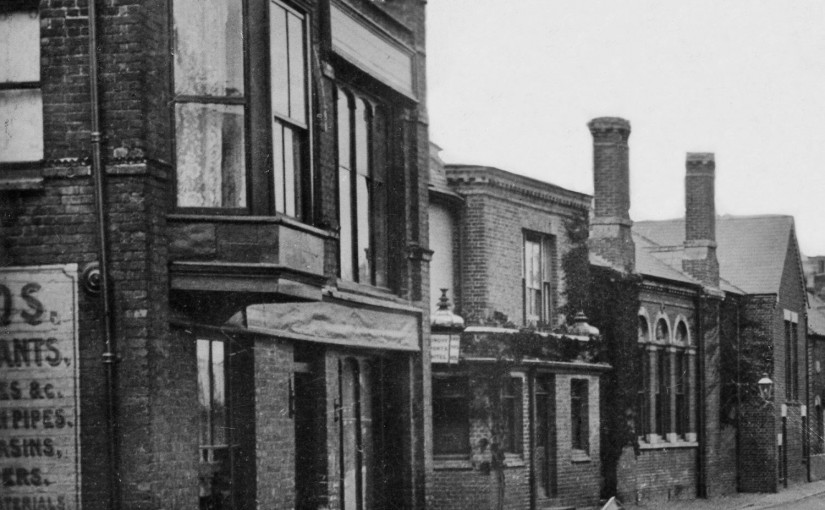The Pubs of Rye no. 8.
The Cinque Ports Arms Assembly Room, Cinque Ports Street.
by David Russell.
The foundation stone for the Cinque Ports Assembly Room was laid in August 1868, and within three months it was open as an integral part of the Cinque Ports Arms. The Assembly Room, which was 50 by 25 feet [15.24m x 7.62m], extended the frontage of the pub to a total of 141 feet [43m], making it one of the largest licensed premises in Rye.
One user remembered the Assembly Room as an unattractive ‘long, narrow shed like building’. For Rye’s commercial and working classes at least, it quickly became a major entertainment venue and meeting place. For the next 60 years or so it was widely used by a large variety of groups and organisations.
A list of those organisations who used both the pub and Assembly Room is endless but includes: the Rye Literary Debating and Elocution Society, the Quadrille Invitation Society, Rye Community Association, Orpheus Glee Union, Rye Cricket Club, Rye Suffragettes, Rye Liberal Association, Rye District Commercial Association and the YMCA Choir.
The venue, although licensed, was oddly enough acceptable to the Church of England Temperance Society who in 1905 gave presentations of ‘lantern slides on the evils of alcohol’ to audiences of up to 250. The Church of England Society for Providing Homes for Waifs and Strays also met here.
Several theatre groups and companies put on pantomimes and stage plays over the years, but in 1899 pub landlord, John Reader, was charged for not having a theatre licence. The court decided that he had innocently broken the law, and would be fined 1s [5p] for each of the two days the theatre was open without a licence. The clerk suggested that “someone had been neglecting their duty because for 30 years plays have been performed here without a licence”.In 1905 Ryers found themselves being photographed in the street:
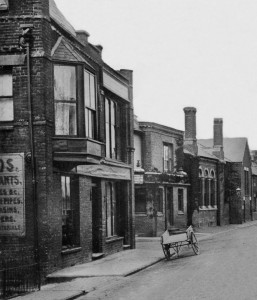
‘A GREAT NOVELTY AT THE CINQUE PORTS ASSEMBLY ROOMS.
A highly interesting novelty is to be put forward by the management in connection with the programme at the Cinque Ports Assembly Rooms on Tuesday and Wednesday evenings next, February 28th and March 1st. For some days past operators have been busy with their cameras, taking snapshots ‘here, there, and everywhere’, as the saying goes, and dozens of residents have been taken unbeknown to themselves. On the evenings of Tuesday and Wednesday next, these pictures will be placed in a box to be picked out by an independent member of the audience and then handed to the stage manager for the purpose of showing on a screen by a powerful lime-light bioscope. Should the originals of the pictures be in the hall they have only to step forward and claim the reward, in the shape of a handsome watch, walking – stick, or umbrella. Three pictures will be shown each evening, so that all the prizes are to be won. If your photograph does not come out on Tuesday it may on Wednesday. In addition to the above competition there is a splendid programme, including a drama in two scenes —a screaming farcical comedy and the wonderful ‘Valan’ in his entertainment of mystery, together with a number of other artistes of repute. In putting this entertainment before the Rye public it is hoped there will be a good attendance, and if well supported it will not be the last of such programmes whereby the public will benefit. ‘
By now the Cinque Ports Arms was tied to the Edwin Finn Brewery of Lydd, and in March 1913 they renamed the Assembly Room the Bijou Theatre, and applied for permission to make alterations allowing it to be used for cinematograph performances. The alterations also included installing electric light and updating the seating.
The Bijou Theatre opened on Easter Monday 1913 under the direction of Francis Bertram, whose stated aim was ‘to provide the people of Rye with some highly refined hours of amusement’. The re-opening performance was described as ‘a venture in vaudeville, presenting a combination of music, mirth and mystery and starring some novel and startling illusions, cabinet seances etc’.
‘BIJOU THEATRE.—It will be pleasing to the patrons of this theatre to know that the proprietor, Mr. Francis Bertram, will next week present, in addition to his usual attractive programme of picture novelties, a unique and charming Vaudeville attraction. The Four Happy-go-Lucky Girls will appear in a whirlwind of song and dance. They are direct from the London music halls. The pictures for the latter part of this week are being greatly appreciated, especially the story of “Dan Patterson, detective”, which depicts some most remarkable and powerful plots and counterplots.’
Bertram also promised that ‘constant changes of programme will be the order of the day, intermittently combining vaudeville, drama and cinematography’. By this date the Bijou was also under the influence of the music hall, and indeed several performers who visited Rye came from that genre.
A century ago just after the outbreak of the First World War, the Bijou, now managed by John Hunter (formerly Entertainments Manager of Hastings Pier Pavilion), came to the attention of the police a second time. In December Hunter was charged with using the theatre to run a lottery. It was claimed ‘that he did unlawfully sell certain tickets or chances not authorised by Parliament, to wit, a lottery for postal orders in an amusement house known as the Bijou Theatre’.
It was also claimed that: ‘the case was of great importance because people were under the impression that this kind of lottery could legally be held. The programme, which sold for a penny, bore numbers, and at the conclusion of the concert Mr Hunter distributed money prizes to members of the audience who had programmes bearing certain numbers corresponding with those previously placed in an envelope. This we consider a very serious offence.’
Sergeant Sinclair of the Rye police said he went to the Bijou and paid 6d [2½p] admission. “The performance consisted of singing, dancing and pictures.” At the end of the performance Mr Hunter stated from the platform that he had 15 prizes to distribute as a reward for patronage. After various witnesses were called, the magistrates considered that the case was proved, but said, “as there has been no similar charge before the Justices in Rye, we consider that Mr Hunter acted innocently and the case will be dismissed. But any further case will be severely dealt with.”
In 1915 during the war, Ellen Terry, then the leading Shakespearean actress in Britain, on a return visit gave four performances as Portia in The Merchant of Venice. She was supported by various well known actors including Jean Sterling Mackinlay, who also sang a selection of ‘dramatic ballads and folk songs’.
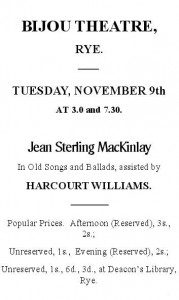
These performances were a sell-out but were heightened by the attendance of invalid soldiers recently returned from the war in France and recuperating in the town. In the same year the Bijou was granted an extension ‘for a Military Ball for Australian soldiers’ billeted in Rye. The magistrates decided wisely, that there will be ‘no intoxicants, the bar will be closed and the rest of the premises shut off’, showing that the Bijou was still part of the Cinque Ports Arms.
From the 1920s screen shows increased in popularity, until eventually in 1932 the theatre was acquired and rebuilt by Shipham and King, proprietors of the Electric Palace, Landgate. It was reported that ‘scenes of enthusiasm accompanied the opening of Rye’s new luxurious cinema, the Regent. Long before the opening a large crowd had collected at the imposing modern building, illuminated by flood and neon lights. Rapidly every one of the 700 seats in the theatre was filled, and over 500 people were turned away. In the finely decorated vestibule were many telegrams congratulating Messrs Shipman and King on their enterprise.’
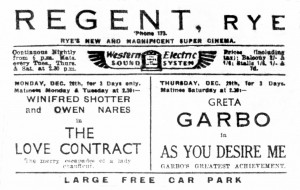
After the new cinema was formerly opened a speaker condemned the current vogue for gangster films. The first film shown was Jacks the Boy starring Jack Hulbert and Cecily Courtenage, supported by Laurel and Hardy and Mickey Mouse. This was followed by a Mayor’s reception in the lounge.
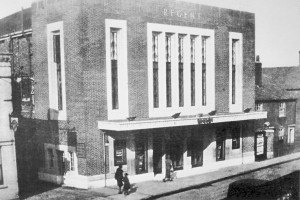
In September 1942 the pub and the cinema were bombed and destroyed. The cinema however was rebuilt and reopened in 1948 and granted a six day licence. It was emphasised that the rebuilt cinema could not be used as a theatre as no safety curtain had been installed, and only a single stage exit was provided. The reopening film My Brother Jonathan starred Michael Dennison and Dulcie Gray.
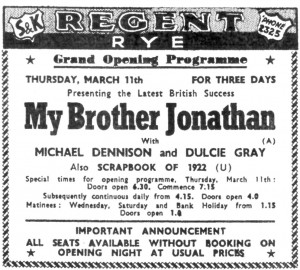
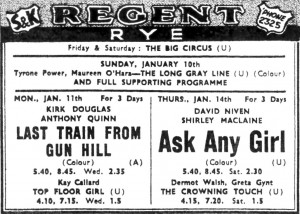
The rebuilt cinema ran from 1948 until 1972,when it finally succumbed to the competition of television. In its final year the Regent, a cinema with 700 seats, attracted an average daily attendance of only 55! The final film was Anne of the Thousand Days shown on 18th June 1972. Thus the Regent outlasted the pub; the Cinque Ports Arms, to which it was once attached, by 30 years.
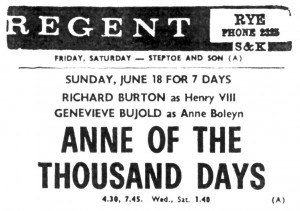
Other pub histories can be found in the book The Pubs of Rye, East Sussex 1750–1950 by David Russell. The book, illustrated with around 100 photographs, is in paperback, 282 pages, priced £13.99. It is available at Martello Bookshop, Adams of Rye, Rye Tourism Information Centre, Rye Heritage Centre and Waterstones in Hastings. It is also available at www.hastingspubhistory.com, by email: [email protected] or phone 01424 200227.
Rye’s Own August 2013
All articles, photographs and drawings on this web site are World Copyright Protected. No reproduction for publication without prior arrangement.
